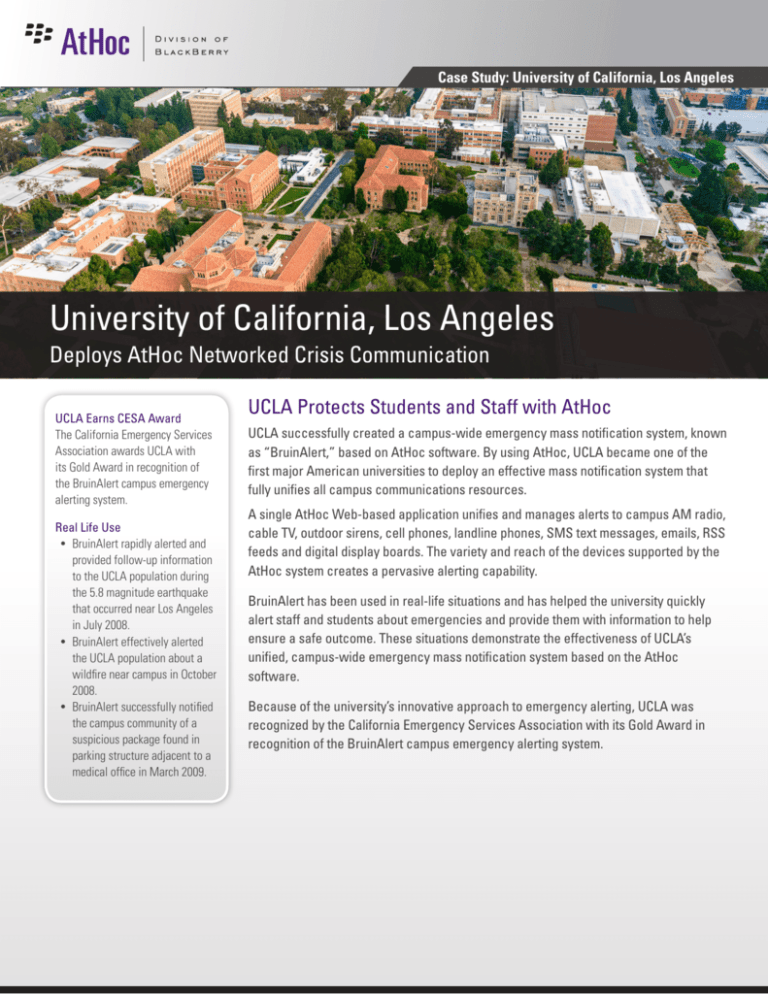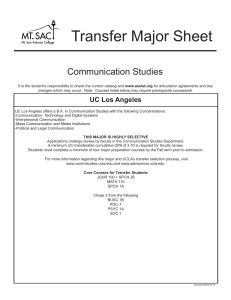
Case Study: University of California, Los Angeles
University of California, Los Angeles
Deploys AtHoc Networked Crisis Communication
UCLA Earns CESA Award
The California Emergency Services
Association awards UCLA with
its Gold Award in recognition of
the BruinAlert campus emergency
alerting system.
Real Life Use
• BruinAlert rapidly alerted and
provided follow-up information
to the UCLA population during
the 5.8 magnitude earthquake
that occurred near Los Angeles
in July 2008.
• BruinAlert effectively alerted
the UCLA population about a
wildfire near campus in October
2008.
• BruinAlert successfully notified
the campus community of a
suspicious package found in
parking structure adjacent to a
medical office in March 2009.
UCLA Protects Students and Staff with AtHoc
UCLA successfully created a campus-wide emergency mass notification system, known
as “BruinAlert,” based on AtHoc software. By using AtHoc, UCLA became one of the
first major American universities to deploy an effective mass notification system that
fully unifies all campus communications resources.
A single AtHoc Web-based application unifies and manages alerts to campus AM radio,
cable TV, outdoor sirens, cell phones, landline phones, SMS text messages, emails, RSS
feeds and digital display boards. The variety and reach of the devices supported by the
AtHoc system creates a pervasive alerting capability.
BruinAlert has been used in real-life situations and has helped the university quickly
alert staff and students about emergencies and provide them with information to help
ensure a safe outcome. These situations demonstrate the effectiveness of UCLA’s
unified, campus-wide emergency mass notification system based on the AtHoc
software.
Because of the university’s innovative approach to emergency alerting, UCLA was
recognized by the California Emergency Services Association with its Gold Award in
recognition of the BruinAlert campus emergency alerting system.
Case Study
Executive Summary
UCLA at a Glance
•
•
•
•
38,000 Students
4,000 Faculty
29,000 Staff
174 Buildings across 419 acres
Requirements
• Unified multi-channel alerting system to
leverage UCLA’s communications assets
• Ability to create and store numerous
emergency scenarios
• Redundant system that supports hot
failover system offsite
• Security and user privacy
• Integration with internal contact directory
so that people can be reached even
without cell phone subscription
• Use of Common Alert Protocol (CAP) to
ensure interoperability
• Enterprise-wide, centralized management
Solution
AtHoc Enterprise Edition:
• Integration with the existing siren system, university radio and cable TV
stations
• Centralized deployment behind the firewall
• Alert triggering from any network-connected PC from a Web browser console
• Reaches 60,000 individuals in minutes
• Integration with multiple user repositories
• Automatic hot failover capability to an offsite location
Results
• Unified alerting to computers, telephones, mobile devices, email, sirens,
campus cable TV, campus radio and the Emergency Digital Information System
• System achieves 97% reach to students according to a UCLA report to FEMA’s
Disaster Resistant Universities (DRU)
• Reduced the time required to reach all students and staff to under five minutes
• UCLA received the California Emergency Services Association (CESA) Gold
Award in recognition of the BruinAlert campus emergency alerting system
The Challenge and the Opportunity Facing UCLA
Every day, more than 60,000 students and staff engage in a variety of activities on the UCLA campus.
Over the years, UCLA’s emergency notification capabilities had evolved to incorporate new technologies. As a result, the
university had a number of separate alerting systems, including bulk email, a toll-free number, AM radio, a cable television
station and a website. No single method of emergency notification could guarantee contact with everyone during an
emergency. For example, many universities rely solely on text alerting for mass notification which limits the ability to reach
the entire population during an emergency. In 2007, UCLA began researching and evaluating network-centric emergency
alerting technologies as a complement to its existing systems.
Before beginning its research, UCLA administrators identified and developed a list of requirements they felt were essential
to a university mass notification system. These included:
• Unified and multi-channel alerting – alerts need to be sent through multiple redundant channels, including radio, cable
•
•
•
•
•
•
TV, sirens, cell phones, SMS text messages, emails, RSS feeds and desktop computers
Rapid alert dissemination across entire campus – in the event of an emergency, alerts need to be delivered as quickly
as possible to everyone on campus within minutes
Scalability to over 60,000 people – with a large and growing population, any notification system needs to reliably support
tens of thousand of users
Not dependent on self subscription – people need to be alerted regardless of whether or not they subscribe to alerts
Redundant system – to remain operational in the case of a data center failure, redundancy must be built into the system
Security – access rights and authorization need to be robust to prevent compromising of the system and alert abuse
Case Study
The Solution
The Deployment
After evaluating numerous technical solutions
and proposals, UCLA selected AtHoc as the
best choice for extending its emergency
alerting capabilities. BruinAlert protects UCLA’s
population by delivering alerts to individuals via
multiple, redundant channels. Alerts are sent
through a single, Web-based application that
manages alert dissemination to:
Onsite behind its firewall, UCLA installed AtHoc. The system was
integrated with the university’s user directories to ensure access to
the most updated contact information for students, faculty and staff
while maintaining security and the privacy of user information. Every
night, the system automatically synchronizes its contact database with
university repositories to update names, email addresses, telephone
numbers and other contact information.
• Telephones (mobile and landline)
• SMS/text messages to mobile devices
•
•
•
•
•
(BlackBerry, PDAs, etc.)
Email
Campus sirens
Campus cable TV and radio
Network-connected computers
(Mac and Windows)
Emergency Digital Information System
(EDIS)
AtHoc provides UCLA with significant cost
savings by leveraging the university’s existing
alerting infrastructure. Its network-centric
approach uses the campus’ IP network to
enable faster mass notification over a large
and geographically-dispersed area.
AtHoc was then integrated with existing mass notification systems
such as the campus radio and cable TV stations, the siren system and
the California’s Emergency Digital Information Service. All integrations
used the Common Alerting Protocol (CAP), a standard for emergency
communications interoperability.
A failover system at an off-site location is incorporated in the AtHoc
system, providing an additional level of redundancy for high reliability
if the primary system goes down.
Operations and Permissions
University personnel with alerting authority can trigger alerts from
any network-connected PC using a Web browser. They can select or
modify a menu of predefined alert scenarios.
The system also has a subscription page to make it as easy as possible
for faculty and students to update their contact information. UCLA
has over 20 custom scenarios covering the most likely emergency
situations the university could encounter, including: earthquakes,
thunderstorms, campus violence and hazardous material spills.
Case Study
The 2008 Earthquake
On July 29, 2008, a 5.8 magnitude
earthquake struck the greater Los Angeles
area. Emergency managers at UCLA
successfully used AtHoc to notify the
campus population.
Within minutes of the earthquake, the first
alerts were sent out as emails and SMS/
text messages. Students were informed
that an earthquake had taken place and
were warned about aftershocks. They were
also directed to tune into the campus radio
station for additional instructions.
This alert was the first actual emergency
use of the AtHoc system since it was
deployed by UCLA in November of 2007.
Triggering an alert is simple. “We just add the location of the emergency, fill
in the blanks, target the recipient groups and send out the alert,” said David
Burns, emergency manager for UCLA.
By combining mass broadcast notification with personalized alerting,
the university can achieve an exceptionally high rate of student and staff
notification.
Once AtHoc was deployed, UCLA began a campaign to promote awareness of and participation in the alert system. For the
initial launch, the General Services Emergency Management office sent over 47,000 messages, including SMS/text messages,
emails and desktop notifications to students, faculty and staff.
Results and Benefits
Today, UCLA’s BruinAlert is used to protect more than 60,000 people across campus.
Unified alerting can now be triggered to computers, telephones, mobile devices,
email, sirens, campus cable TV, campus radio and the Emergency Digital
Information System, reducing the time required to reach all students and staff.
UCLA Earns Award
The California Emergency Services
Association awarded UCLA its Gold
Award in recognition of the BruinAlert
campus emergency alerting system.
The UCLA Bruin Alert System consistently reaches more than 99% of subscribers.
Protect Your Community
AtHoc is committed to making the world safer. Join us today:
• Call: (650) 685-3000; outside the U.S. +1 (650) 685-3000
• Email: demo@athoc.com
AtHoc, Inc. 2988 Campus Drive Suite 100 San Mateo CA 94403
Tel: +1.650.685.3000 | Fax: +1.650.685.3010
©2015 AtHoc, Inc. All rights reserved.



